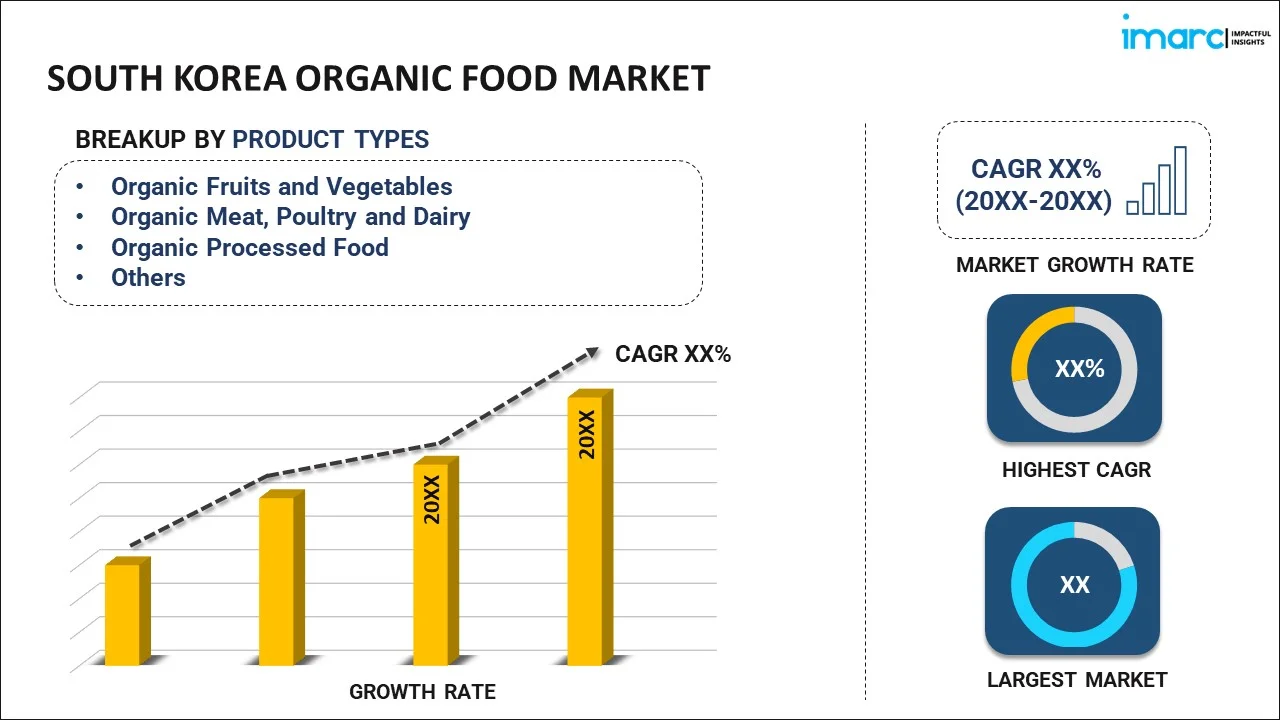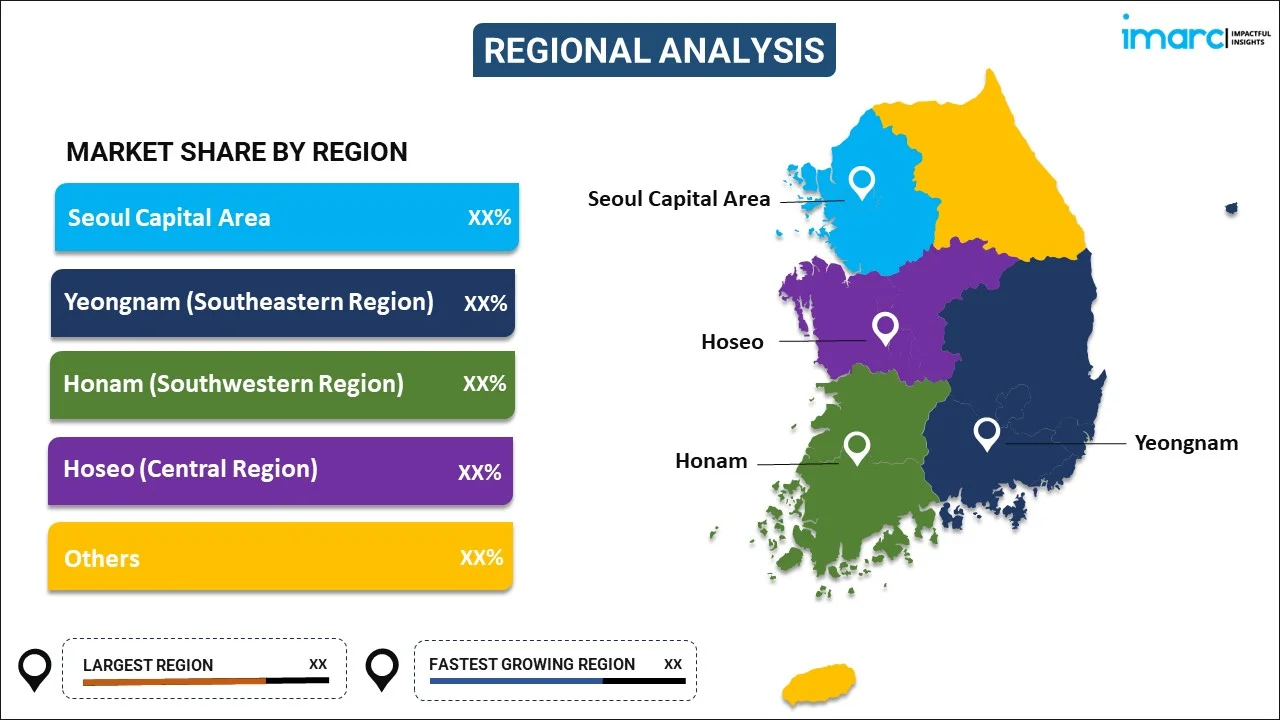
South Korea Organic Food Market Report by Product Type (Organic Fruits and Vegetables, Organic Meat, Poultry and Dairy, Organic Processed Food, Organic Bread and Bakery, Organic Beverages, Organic Cereal and Food Grains, and Others), Distribution Channel (Supermarkets and Hypermarkets, Specialty Stores, Convenience Stores, Online Stores, and Others), Application (Bakery and Confectionery, Ready-to-eat Food Products, Breakfast Cereals, and Others), and Region 2024-2032
Market Overview:
South Korea organic food market size is projected to exhibit a growth rate (CAGR) of 7.60% during 2024-2032. The establishment and enforcement of organic certification standards by government bodies that contribute to consumer confidence in the authenticity of organic products, is driving the market.
|
Report Attribute
|
Key Statistics
|
|---|---|
|
Base Year
|
2023 |
|
Forecast Years
|
2024-2032 |
|
Historical Years
|
2018-2023
|
| Market Growth Rate (2024-2032) | 7.60% |
Organic food refers to agricultural products cultivated without synthetic pesticides, fertilizers, genetically modified organisms (GMOs), or irradiation. Instead, organic farming relies on natural processes and sustainable practices to enhance soil fertility, control pests, and promote biodiversity. Organic farmers prioritize the use of compost, crop rotation, and biological pest control methods to maintain soil health and minimize environmental impact. In addition to avoiding synthetic chemicals, organic livestock farming emphasizes humane treatment, providing animals with access to outdoor spaces and organic feed. The organic certification process involves rigorous standards to ensure compliance with these principles. Consumers often choose organic food for its perceived health benefits, reduced environmental impact, and support for sustainable agricultural practices. While studies on the nutritional superiority of organic versus conventionally grown food remain inconclusive, the organic movement continues to grow as individuals seek alternatives aligned with ecological and ethical considerations.
South Korea Organic Food Market Trends:
The organic food market in South Korea has witnessed remarkable growth over the past few years, driven by increasing consumer awareness of health and environmental concerns. Firstly, consumers are becoming more conscious of the potential harmful effects of pesticides and synthetic chemicals in conventional agriculture. Consequently, they are actively seeking healthier alternatives, propelling the demand for organic produce. Additionally, the growing trend towards sustainable and environmentally friendly practices has further fueled the organic food market. This is exemplified by the rising interest in regenerative agriculture, which focuses on restoring soil health and promoting biodiversity. Furthermore, the surge in lifestyle-related diseases has prompted individuals to adopt healthier dietary habits, with organic food being perceived as a wholesome and nutrient-rich option. Moreover, the millennial and Gen Z demographics, known for their emphasis on sustainability and ethical consumption, have become key drivers of the organic food market. Social media platforms and digital communication have played a pivotal role in disseminating information about the benefits of organic products, influencing purchasing decisions across diverse demographics. In conclusion, a confluence of factors, including health consciousness, environmental sustainability, and changing consumer demographics, has contributed to the burgeoning growth of the organic food market in South Korea.
South Korea Organic Food Market Segmentation:
IMARC Group provides an analysis of the key trends in each segment of the market, along with forecasts at the country level for 2024-2032. Our report has categorized the market based on product type, distribution channel, and application.
Product Type Insights:

- Organic Fruits and Vegetables
- Organic Meat, Poultry and Dairy
- Organic Processed Food
- Organic Bread and Bakery
- Organic Beverages
- Organic Cereal and Food Grains
- Others
The report has provided a detailed breakup and analysis of the market based on the product type. This includes organic fruits and vegetables, organic meat, poultry and dairy, organic processed food, organic bread and bakery, organic beverages, organic cereal and food grains, and others.
Distribution Channel Insights:
- Supermarkets and Hypermarkets
- Specialty Stores
- Convenience Stores
- Online Stores
- Others
A detailed breakup and analysis of the market based on the distribution channel have also been provided in the report. This includes supermarkets and hypermarkets, specialty stores, convenience stores, online stores, and others.
Application Insights:
- Bakery and Confectionery
- Ready-to-eat Food Products
- Breakfast Cereals
- Others
The report has provided a detailed breakup and analysis of the market based on the application. This includes bakery and confectionery, ready-to-eat food products, breakfast cereals, and others.
Regional Insights:

- Seoul Capital Area
- Yeongam (Southeastern Region)
- Honam (Southwestern Region)
- Hoseo (Central Region)
- Others
The report has also provided a comprehensive analysis of all the major regional markets, which include Seoul Capital Area, Yeongam (Southeastern Region), Honam (Southwestern Region), Hoseo (Central Region), and Others.
Competitive Landscape:
The market research report has also provided a comprehensive analysis of the competitive landscape in the market. Competitive analysis such as market structure, key player positioning, top winning strategies, competitive dashboard, and company evaluation quadrant has been covered in the report. Also, detailed profiles of all major companies have been provided.
South Korea Organic Food Market Report Coverage:
| Report Features | Details |
|---|---|
| Base Year of the Analysis | 2023 |
| Historical Period | 2018-2023 |
| Forecast Period | 2024-2032 |
| Units | US$ Million |
| Scope of the Report | Exploration of Historical Trends and Market Outlook, Industry Catalysts and Challenges, Segment-Wise Historical and Future Market Assessment:
|
| Product Types Covered | Organic Fruits and Vegetables, Organic Meat, Poultry and Dairy, Organic Processed Food, Organic Bread and Bakery, Organic Beverages, Organic Cereal and Food Grains, Others |
| Distribution Channels Covered | Supermarkets and Hypermarkets, Specialty Stores, Convenience Stores, Online Stores, Others |
| Applications Covered | Bakery and Confectionery, Ready-to-eat Food Products, Breakfast Cereals, Others |
| Regions Covered | Seoul Capital Area, Yeongnam (Southeastern Region), Honam (Southwestern Region), Hoseo (Central Region), Others |
| Customization Scope | 10% Free Customization |
| Report Price and Purchase Option | Single User License: US$ 3699 Five User License: US$ 4699 Corporate License: US$ 5699 |
| Post-Sale Analyst Support | 10-12 Weeks |
| Delivery Format | PDF and Excel through Email (We can also provide the editable version of the report in PPT/Word format on special request) |
Key Questions Answered in This Report:
- How has the South Korea organic food market performed so far and how will it perform in the coming years?
- What has been the impact of COVID-19 on the South Korea organic food market?
- What is the breakup of the South Korea organic food market on the basis of product type?
- What is the breakup of the South Korea organic food market on the basis of distribution channel?
- What is the breakup of the South Korea organic food market on the basis of application?
- What are the various stages in the value chain of the South Korea organic food market?
- What are the key driving factors and challenges in the South Korea organic food?
- What is the structure of the South Korea organic food market and who are the key players?
- What is the degree of competition in the South Korea organic food market?
Key Benefits for Stakeholders:
- IMARC’s industry report offers a comprehensive quantitative analysis of various market segments, historical and current market trends, market forecasts, and dynamics of the South Korea organic food market from 2018-2032.
- The research report provides the latest information on the market drivers, challenges, and opportunities in the South Korea organic food market.
- Porter's five forces analysis assist stakeholders in assessing the impact of new entrants, competitive rivalry, supplier power, buyer power, and the threat of substitution. It helps stakeholders to analyze the level of competition within the South Korea organic food industry and its attractiveness.
- A competitive landscape allows stakeholders to understand their competitive environment and provides an insight into the current positions of key players in the market.
Need more help?
- Speak to our experienced analysts for insights on the current market scenarios.
- Include additional segments and countries to customize the report as per your requirement.
- Gain an unparalleled competitive advantage in your domain by understanding how to utilize the report and positively impacting your operations and revenue.
- For further assistance, please connect with our analysts.
 Inquire Before Buying
Inquire Before Buying
 Speak to an Analyst
Speak to an Analyst
 Request Brochure
Request Brochure
 Request Customization
Request Customization




.webp)




.webp)












